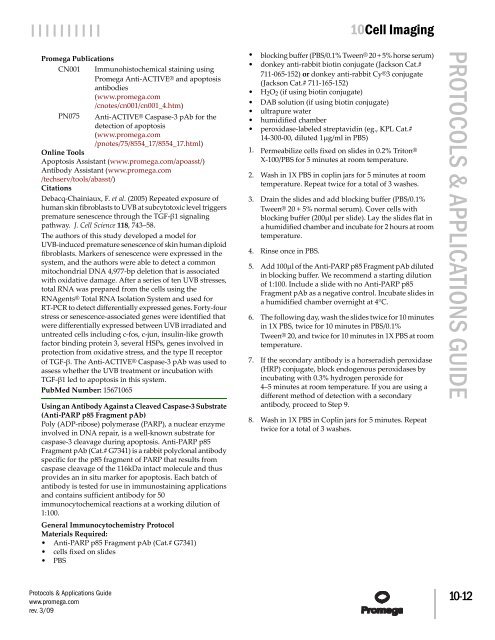Protocols and Applications Guide (US Letter Size) - Promega
Protocols and Applications Guide (US Letter Size) - Promega
Protocols and Applications Guide (US Letter Size) - Promega
Create successful ePaper yourself
Turn your PDF publications into a flip-book with our unique Google optimized e-Paper software.
|||||||||| 10Cell Imaging<br />
<strong>Promega</strong> Publications<br />
CN001 Immunohistochemical staining using<br />
<strong>Promega</strong> Anti-ACTIVE® <strong>and</strong> apoptosis<br />
antibodies<br />
(www.promega.com<br />
/cnotes/cn001/cn001_4.htm)<br />
PN075 Anti-ACTIVE® Caspase-3 pAb for the<br />
detection of apoptosis<br />
(www.promega.com<br />
/pnotes/75/8554_17/8554_17.html)<br />
Online Tools<br />
Apoptosis Assistant (www.promega.com/apoasst/)<br />
Antibody Assistant (www.promega.com<br />
/techserv/tools/abasst/)<br />
Citations<br />
Debacq-Chainiaux, F. et al. (2005) Repeated exposure of<br />
human skin fibroblasts to UVB at subcytotoxic level triggers<br />
premature senescence through the TGF-β1 signaling<br />
pathway. J. Cell Science 118, 743–58.<br />
The authors of this study developed a model for<br />
UVB-induced premature senescence of skin human diploid<br />
fibroblasts. Markers of senescence were expressed in the<br />
system, <strong>and</strong> the authors were able to detect a common<br />
mitochondrial DNA 4,977-bp deletion that is associated<br />
with oxidative damage. After a series of ten UVB stresses,<br />
total RNA was prepared from the cells using the<br />
RNAgents® Total RNA Isolation System <strong>and</strong> used for<br />
RT-PCR to detect differentially expressed genes. Forty-four<br />
stress or senescence-associated genes were identified that<br />
were differentially expressed between UVB irradiated <strong>and</strong><br />
untreated cells including c-fos, c-jun, insulin-like growth<br />
factor binding protein 3, several HSPs, genes involved in<br />
protection from oxidative stress, <strong>and</strong> the type II receptor<br />
of TGF-β. The Anti-ACTIVE® Caspase-3 pAb was used to<br />
assess whether the UVB treatment or incubation with<br />
TGF-β1 led to apoptosis in this system.<br />
PubMed Number: 15671065<br />
Using an Antibody Against a Cleaved Caspase-3 Substrate<br />
(Anti-PARP p85 Fragment pAb)<br />
Poly (ADP-ribose) polymerase (PARP), a nuclear enzyme<br />
involved in DNA repair, is a well-known substrate for<br />
caspase-3 cleavage during apoptosis. Anti-PARP p85<br />
Fragment pAb (Cat.# G7341) is a rabbit polyclonal antibody<br />
specific for the p85 fragment of PARP that results from<br />
caspase cleavage of the 116kDa intact molecule <strong>and</strong> thus<br />
provides an in situ marker for apoptosis. Each batch of<br />
antibody is tested for use in immunostaining applications<br />
<strong>and</strong> contains sufficient antibody for 50<br />
immunocytochemical reactions at a working dilution of<br />
1:100.<br />
General Immunocytochemistry Protocol<br />
Materials Required:<br />
• Anti-PARP p85 Fragment pAb (Cat.# G7341)<br />
• cells fixed on slides<br />
• PBS<br />
<strong>Protocols</strong> & <strong>Applications</strong> <strong>Guide</strong><br />
www.promega.com<br />
rev. 3/09<br />
• blocking buffer (PBS/0.1% Tween® 20 + 5% horse serum)<br />
• donkey anti-rabbit biotin conjugate (Jackson Cat.#<br />
711-065-152) or donkey anti-rabbit Cy®3 conjugate<br />
(Jackson Cat.# 711-165-152)<br />
• H2O2 (if using biotin conjugate)<br />
• DAB solution (if using biotin conjugate)<br />
• ultrapure water<br />
• humidified chamber<br />
• peroxidase-labeled streptavidin (eg., KPL Cat.#<br />
14-300-00, diluted 1µg/ml in PBS)<br />
1. Permeabilize cells fixed on slides in 0.2% Triton®<br />
X-100/PBS for 5 minutes at room temperature.<br />
2. Wash in 1X PBS in coplin jars for 5 minutes at room<br />
temperature. Repeat twice for a total of 3 washes.<br />
3. Drain the slides <strong>and</strong> add blocking buffer (PBS/0.1%<br />
Tween® 20 + 5% normal serum). Cover cells with<br />
blocking buffer (200µl per slide). Lay the slides flat in<br />
a humidified chamber <strong>and</strong> incubate for 2 hours at room<br />
temperature.<br />
4. Rinse once in PBS.<br />
5. Add 100µl of the Anti-PARP p85 Fragment pAb diluted<br />
in blocking buffer. We recommend a starting dilution<br />
of 1:100. Include a slide with no Anti-PARP p85<br />
Fragment pAb as a negative control. Incubate slides in<br />
a humidified chamber overnight at 4°C.<br />
6. The following day, wash the slides twice for 10 minutes<br />
in 1X PBS, twice for 10 minutes in PBS/0.1%<br />
Tween® 20, <strong>and</strong> twice for 10 minutes in 1X PBS at room<br />
temperature.<br />
7. If the secondary antibody is a horseradish peroxidase<br />
(HRP) conjugate, block endogenous peroxidases by<br />
incubating with 0.3% hydrogen peroxide for<br />
4–5 minutes at room temperature. If you are using a<br />
different method of detection with a secondary<br />
antibody, proceed to Step 9.<br />
8. Wash in 1X PBS in Coplin jars for 5 minutes. Repeat<br />
twice for a total of 3 washes.<br />
PROTOCOLS & APPLICATIONS GUIDE 10-12
















